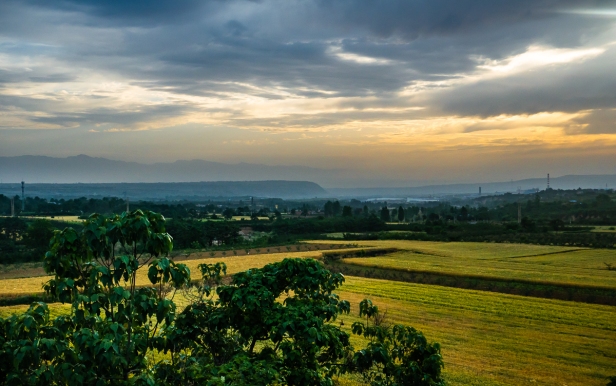
19 May-8 June 2018.
We’re hanging out in the crowded main station in Xi’an waiting for our train to Emei Shan. We have our luggage all stacked together in a pile. Some of us are sitting on the floor,
and the rest of us are hanging out nearby, when suddenly it happens. A young Chinese woman comes rushing up to us squealing and jumping up and down like a little kid because she is so excited to see foreigners. At least that’s what we think it is. Her energy is loud, boisterous, uncontained, uninhibited. She is loud, boisterous, and uninhibited.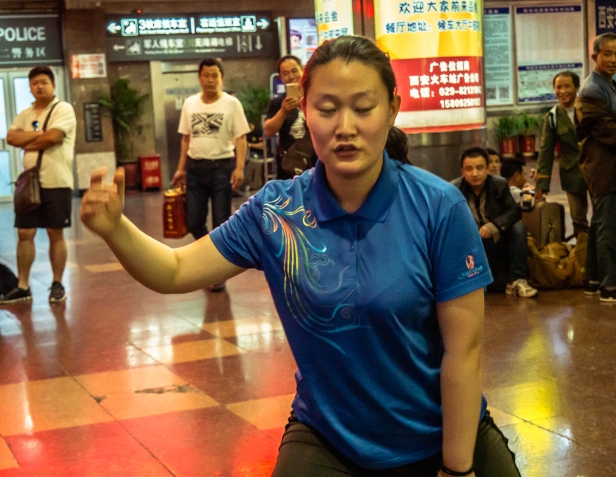
The squealing and jumping up and down continues as she latches on to Belinda who is her new best friend!
She gives Belinda a big hug then races off to make a phone call. She runs back, jumping up and down, hugs all of us, does some tai chi as Bhakti joins in, hugs us all again, and Belinda over and over, all with this manic energy. It goes on for at least half an hour. The more energetic and louder she gets the greater grows the audience around us. There had been some people just standing and staring at us as we waited in the railway station in a group with our luggage. They’d probably never, or rarely, seen foreigners before. We were pretty much the only foreigners in the crowded station, but when the girl starts interacting with us in such a noisy and rambunctious way the audience grows until everyone in the vicinity is watching. The one thing we glean about her is that she’s training to be a kindergarten teacher. How appropriate. Her energy is joyful and infectious, and even though it perhaps goes on for a bit too long we are all smiling. I have never experienced anything quite like it. She’s so uncontained in her excitement, like there’s nothing holding her together, that any minute I think she might explode.
And then our train comes, and her train comes, and we part ways. Peace returns as we collect our luggage and follow Peter onto the platform, and onto the train.
China is a huge country, roughly the same size as the USA, and over a three–week period the eight of us plus our fearless leader travel the length of it in a zigzag pattern from Beijing to Hong Kong, a distance of over four thousand five hundred kilometres. In order to cover the vast distances our itinerary includes three overnight train trips.
In a staggeringly short period of time, over the past ten years, China has developed the biggest high-speed rail network in the world: it has eight times as much track as France, ten times as much as Japan, twenty times as much as the UK, and five hundred times as much as the USA. China has more high-speed track than all the rest of the world combined. We do take two relatively short bullet train journeys, but it is the slow overnight journeys that allow us to see the countryside, to spend time together, to unwind from sightseeing, and to have a truly local experience.
Our first overnight trip begins at Beijing West Station, a crowded, noisy, cavernous, and bewildering space with a huge airport-style departures board.
Here we are camped out waiting for the train in the best spot we could find, right next to the women’s bathroom.
We take turns perusing the many small convenience stores for food to take with us. We are headed to Xi’an, a twelve-hour journey covering a distance of nearly 1300 kilometres. It’s our first introduction to “hard sleeper” compartments. Most trains have “hard sleeper” carriages, “soft sleeper” carriages, and carriages with seats. “Hard sleeper” carriages have six-berth compartments; three berths either side of a narrow space with a small table. The mattresses, despite the name, do have a bit of softness to them; they’re at least better than a camping pad. Each compartment is open to the aisle where there are fold-down seats for staring out the window.
By random computer draw I am assigned to the top bunk. The only way up there is on single footholds at each level on either side of the space between the bunks. Somehow I have to get up onto the first step, straddle the space and up climb up to the next level. I’m pretty darn agile and flexible for my age but I’m so grateful that Bhakti, who has been assigned a middle bunk, agrees to swap with me. And relieved when she tells me the next morning that she slept well.
You can see how narrow the bunks are.
The upper two levels are even narrower, and closer together so one is barely able to sit up. And as you can see, somehow we manage to cram all our luggage into the space, including under the bunks and on the luggage rack above the aisle windows. It’s very cosy.
There are squat toilets at the end of each carriage, but if you walk a long way through several carriages until you come to the “soft sleeper” carriages, which have only four (wider) bunks per compartment, there are western toilets. Oh joy. No really! There are also three sinks for washing in each carriage, and stations for boiling water for tea or noodles.
We settle in and get out all our goodies for dinner. There is a dining car and some have opted to go to it, but most of us have bags full of snacks, and we have a picnic where we are. I have cashews, nuts and raisins, a couple of hard-boiled eggs that I’d filched from the breakfast buffet at the hotel that morning, nectarines, two bananas, and a bizarre bun thing that is sealed in cellophane. I’d bought it in Beijing and have no idea what it is – if it’s sweet or savoury, bread or cake. I show it to Peter who says the topping is seaweed and pork bits so I assume it’s savoury and decide I’ll have it for dinner with the eggs. It turns out the glazing with the seaweed and pork bits is sweet. That’s a surprise. I’m munching away on my egg and take a bigger bite of the bun only to discover it has a sweet vanilla cream filling. That’s really a surprise!
We fill the time chatting, reading, and staring out the window at the countryside.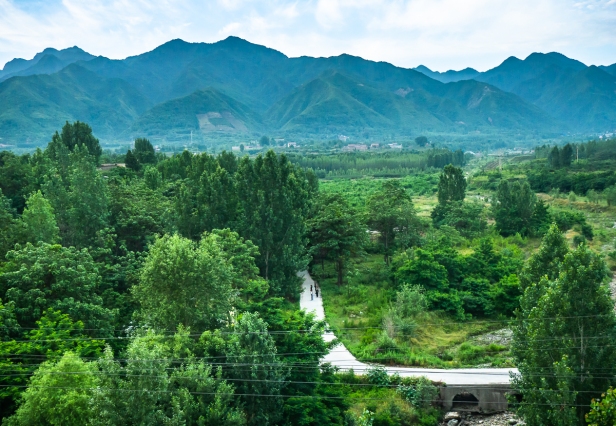
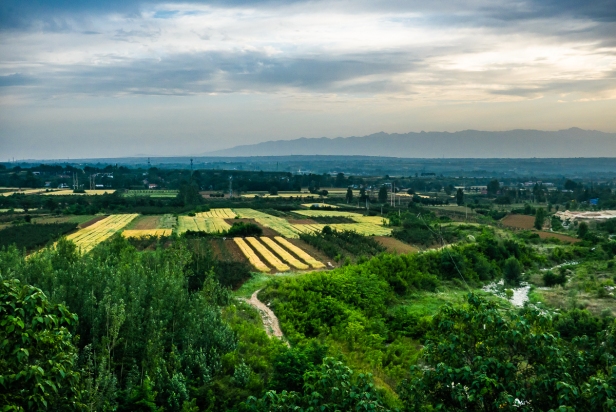
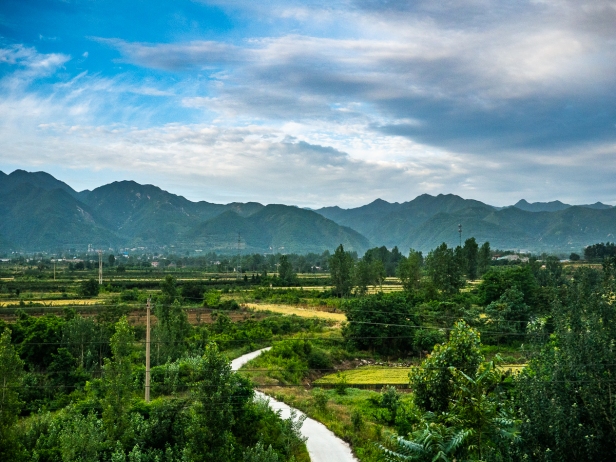

Next morning I’m able to make my usual wake-me-up cup of tea; there’s boiling water available, and the little milk I’d brought with me survived the night.
Trains reach almost every town the length and breadth of China and are safe, reliable, punctual, and cheap. They are the great people-movers in this country of 1.4 billion. The stations are huge, and incredibly busy and noisy, and tickets sell out almost immediately they become available. Each ticket is personalised to prevent a black market arising from bulk-buying and reselling.
I am incredibly grateful to have Peter who takes care of getting us to the stations in plenty of time, and collects our tickets, gets us to the right platform, and into the right carriage. He is our guiding light through a zoo of humanity and confusing signage. It’s possible to travel by train independently in China, and there is quite a lot of information online about how to do it, but I’m glad I didn’t have to.
After leaving our very enthusiastic new friend, the would-be kindergarten teacher and BFF of Belinda, at the station in Xi’an we board the second “hard sleeper” train of our journey south. This time it’s overnight and most of the next day, taking us to Emeishan Town.
Once again by random draw I’m allotted the top bunk. I choose not to swap even though it’s offered. Since it’s happened two times in a row I figure it’s my destiny to sleep on high. And anyway everyone has to take their turn. Also in this train there is a ladder, not just footholds on either side of the gap between the bunks. I know I can negotiate a ladder with no problem.

In the photo above, you can see the bottom bunks by my shoulder, the middle bunks just above my head, and the top bunks way up high near the top of the picture. It’s a long way up. I didn’t sleep well, but then neither did anyone else, and we all survived. I remember years ago, back in my Hippie days, asking a friend how her trip had been. She replied Sometimes it was fun, sometimes it was dirty and there was no place to sleep all said in a very matter-of-fact voice, and as if there was no need to expand on that simple statement. It’s the way of travel isn’t it?
The “hard sleeper” carriages are grubby, crowded, and noisy. They are like a huge dorm room. As you make your way up and down the aisles you pass people playing cards, shelling and eating sunflower seeds, smoking in the allowable space between carriages, or simply staring out the window.
They gather in groups to talk, and at meal times come together to eat, usually the ubiquitous instant noodles. Strangers quickly become friends and a holiday atmosphere arises. Food carts selling noodle pots, soft drinks, and mysterious Chinese snacks negotiate the narrow aisle from time to time.
Out the window I see rice fields and rural homes,
rice fields and a village filling a long valley,
rice fields and huge power stations,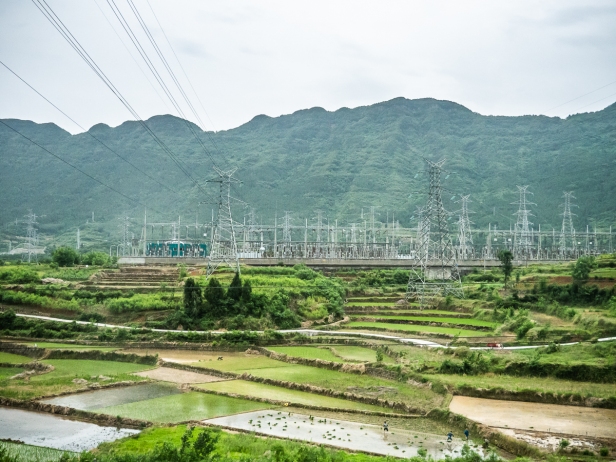
more rice fields,
irrigation canals,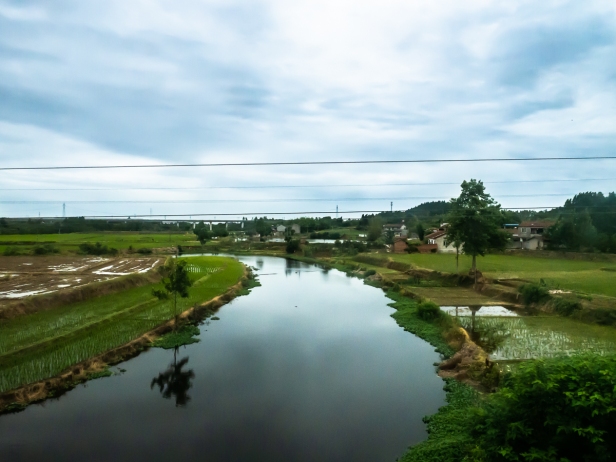
farm houses,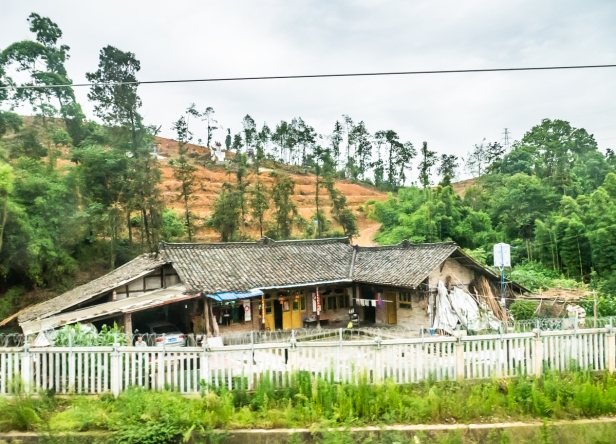
crops of corn and other vegetables,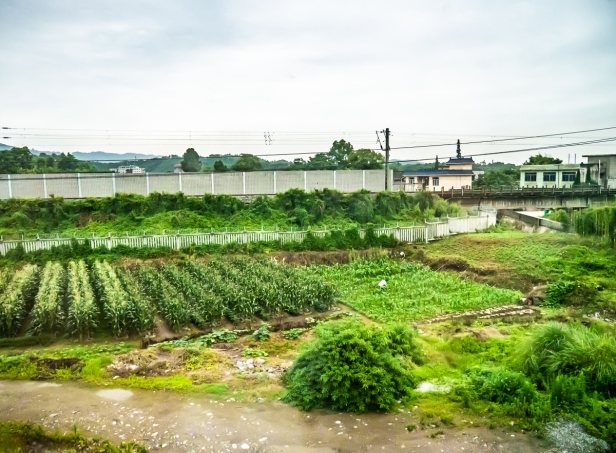
a sleepy turquoise river valley nestled between green mountains,
and new high-rise apartment buildings, marching like great battalions across the land. (The second photo was taken from a bus on a highway but is similar to many I saw from the train).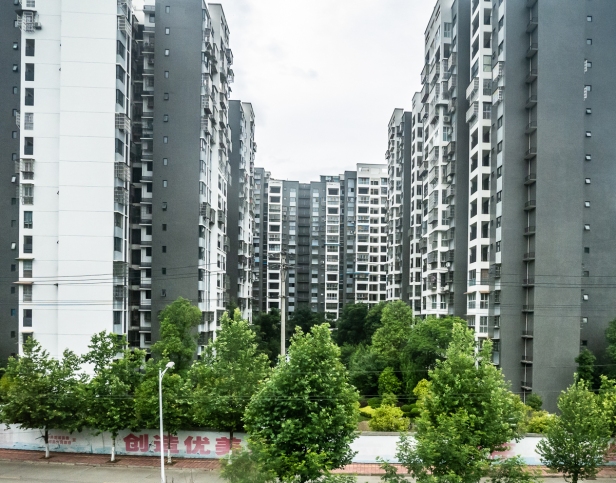

We mainly hang out in our cosy cubicle gabbing about this and that, telling stories, telling jokes, laughing, reading, writing.


In the morning I walk the length of six carriages to find a western toilet. And then wash my face and hands. I’d made sure to have soap and a small towel easily available in my luggage. Neither toilet paper, nor soap, nor towels of any kind are provided. But I am prepared, and it’s amazing the difference it makes just to have clean face and hands. So happy.
Later in the day, when the need arises, instead of walking six carriages to a western toilet I go into one of the squat toilets nearby. Needless to say this is not a pristine place. I hitch up my pant legs and clamp them in place with my knees. I’m sure you can imagine why I don’t want them touching the floor as I pull my pants down. When I’m finished, and still standing in place doing up my pants, the toilet suddenly self-flushes! Spraying water (well I hope it’s only water) all over my legs! That’s a surprise! Ewwwww. I can’t connect the two: a stinky old-fashioned squat toilet on a train with a self-flushing mechanism. It seems such an unlikely juxtaposition.
Some of us go to the dining car for lunch and I have pork with rice, black fungus, and cucumber, cooked in the usual delicious Chinese sauces. So good.
Several days later we are on the third overnight train. This one takes us from Yichang near the Three Gorges Dam, to Liuzhou, a journey of about 950 kilometres and sixteen hours. We’ve just finished a three-night Yangtze River cruise ending at the Three Gorges Dam. From there we travel by bus to some mystery point where we change to another bus that brings us to the station at Yichang. And here is luxury! For this trip we’re in a “soft sleeper” carriage. There are only four beds per compartment, and the beds are softer and wider. Deluxe!
Once again I’m allotted a top bunk! But this time I’m glad. At the foot of my bunk is a huge shelf that forms the roof over the aisle, and it is here that I can stow all my things (suitcase, backpack, camera, bags of snacks) and be able to get at them easily without disturbing anyone. Oh the little things that make me happy!
We’re on this train from the afternoon into the following very early morning. I spend the time talking with the others, uploading and editing photos, and gazing out the window as we pass by mountains and rivers,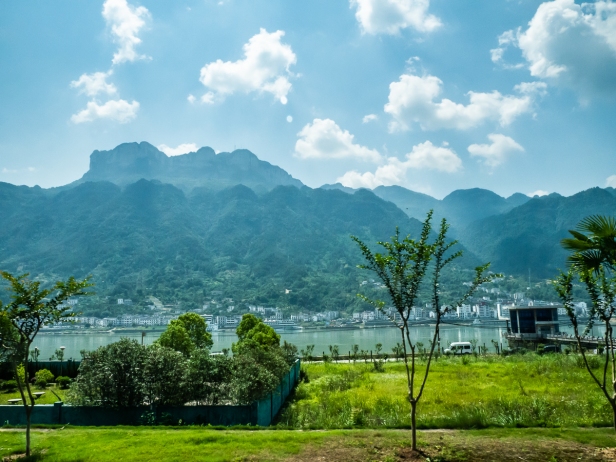

and more small farms and rice fields.

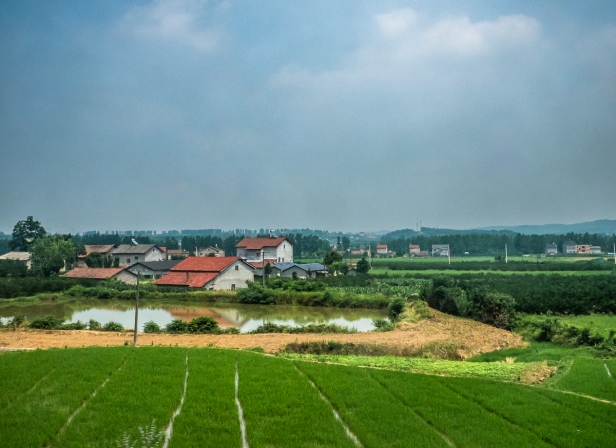
I’m lulled into stillness as the green scenery passes before me. At times it’s almost as if the scenery is moving and I am the one that is still. Eventually I climb up to my bunk and embraced by comfort for a couple of hours I fall into a deep sleep.
Most of us have dinner in the dining car,
where Bhakti swipes the conductor’s hat.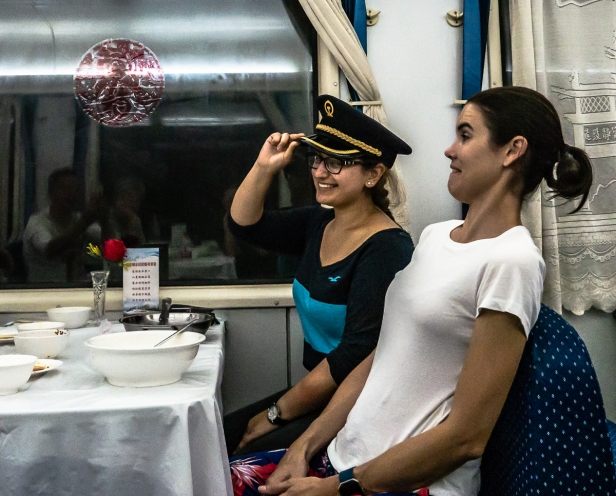
Again the food is good. I have the usual pork and rice, this time with black fungus, carrots, and onions. Belinda and Bhakti each order soup and it arrives not as we Westerners expect, in a soup bowl with a spoon. No, it is served in gigantic basins with ladles!
Of course it is the Asian way – meals are shared so although the rest of us are served individual meals apparently soup only comes in the extra-large size so we can all have some.
I sleep well that night. We are woken at 4.30 am to get off the train at 5 when it arrives in Liuzhou. From there we pile onto a bus for a three-hour drive to Yangshuo.
I’ll mention one other train trip. We get a bullet train from Guilin to Shenzhen where we take a local subway to the border. After leaving China we take another subway, finally arriving in downtown Hong Kong. The high-speed train from Guilin to Shenzhen takes three hours to cover a distance of 500 kilometres. At one point we’re travelling at 308 kilometres per hour.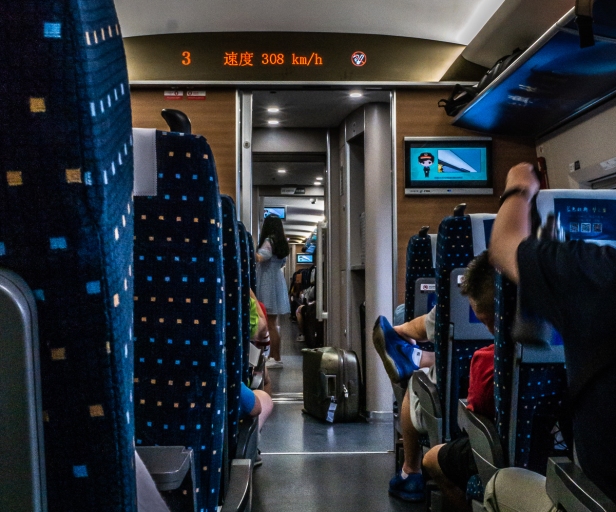
Train window dreaming:
Next post: The famous Terracotta Warriors and the not so famous Han Yang Ling Mausoleum.
All words and images by Alison Louise Armstrong unless otherwise noted
© Alison Louise Armstrong and Adventures in Wonderland – a pilgrimage of the heart, 2010-2019.

Wonderful memories live on again in words and photos. This was a fun Saturday morning reading journey for me… thank you Alison!
LikeLiked by 1 person
Thanks so much Mary. I’m glad you enjoyed it. It was a pretty amazing trip.
Alison
LikeLike
thank you for wonderfully
expressing the look & feel
of really long distance train travel, Alison!
i’ve tried sleeping on choo-chooing trains.
nice to get this glimpse in just couple minutes
rather than days and days and days 🙂
LikeLiked by 1 person
Thank you, and you’re welcome!
Perhaps a glimpse in a couple of minutes
is better than days and days.
I’ve done overnight train journeys in
several countries now. Sometimes I sleep,
sometimes not, but it’s always an adventure.
Alison
LikeLike
Excellent photos again.
LikeLiked by 1 person
Thank you so much Rabirius. I appreciate your support!
Alison
LikeLiked by 1 person
The open lush countryside, the tightly put together sleeping places, the yummy appering meal, what a trip! Another great post from you, Alison. Safe travels, good health, and peace. ❤
LikeLiked by 1 person
Thanks so much Paulette. It really was an amazing journey, and I’m looking forward to sharing all the things we saw and experienced in between these great long train trips. Good health and peace to you too ❤
Alison xo
LikeLike
I felt like I was with you on the train journeys. So descriptive. Great pictures as well.
LikeLiked by 1 person
Thanks so much Darlene. That’s the best compliment, that you felt like you were there with me. The train trips were such a big part of the whole journey.
Alison
LikeLike
The light in the first image is remarkable! What a way to kick things off.
And then it’s ‘pow’ with your first story. I find her enthusiasm seriously curious.
The coziness of the hard bunk is reminiscent of my train journey from North to South Vietnam … but China’s is a more luxurious version
The water spray from the toilet had me roaring with laughter (although it probably didn’t seem very fun at the time). It just seemed like the type of situation that I would find myself in 🙂
Your photos are magnificent, every one of them. They truly make me feel like I am on this journey with you, looking out the windows and the changing landscape and enjoying the creation of new friendships in confined spaces.
I had planned to take a brief rail journey through China in 2017 on a mad-dash from Vietnam to visit my father (who has a business there). In the end, I decided to explore Vietnam more deeply and return someday later to China. But I loved experiencing much of that planned rail journey through this post (and so many other wonderful bits of China through other in your series). Every one of them is encouraging me for a trip there. I think I mentioned elsewhere that my next dream is a rail journey from London to Beijing after we ‘drop the hook’ #cannotwait
LikeLiked by 1 person
Thank you so much Lisa for all your lovely compliments.
I too found the young woman’s behaviour curious, strange, unfathomable. I have no idea what propelled such an outburst from her. Perhaps she was on drugs. We were all a little taken aback by it.
I too did an overnight journey in Vietnam – from Hanoi to Sapa and miraculously managed to sleep. At least the bunk was wider than the ones in the “hard sleeper” trains.
A rail journey from London to Beijing sounds truly amazing. I hope it happens for you! (And I wish it was me!)
Alison
LikeLiked by 1 person
That’s quite some journey! It was lovely to see all the smiles.
LikeLiked by 1 person
Thanks Susan. Yes, it was quite a journey, and we had many fun times together. There were lots of smiles!
Alison
LikeLiked by 1 person
« Sometimes it was fun, sometimes it was dirty and there was no place to sleep all » A simple statement but one that sums up long distance train travel so well. The grunginess, characters, the endless landscape rolling by the window. I’m never able to read on trains, because it’s so mesmerizing. Thanks for the vibrant and detailed account. Good to know such a vast system exists in China, in case I ever find myself there.
LikeLiked by 1 person
Thank you so much JD, and you’re welcome. There was so much richness in the train journeys – the time with others, the time alone, the time staring out the window, even the time of deep napping. We travelled hard in China, so the train journeys were a much needed chance to stop for a bit.
Alison
LikeLike
Quite the trip, Alison. As always, I am impressed with your adventuresome spirit. I agree that having a guide in China makes good sense, although our neighbors are off on a seven week journey through China this summer on their own. 500 times the train tracks that the US has. Wow! –Curt
LikeLiked by 1 person
Thanks Curt. I can’t imagine travelling China without a guide, but obviously people who are more adventurous than me do it all the time. I’m sure your friends will have an amazing time. I have a friend who set off alone for 5 weeks through China without an itinerary apart from some rivers she wanted to see, and managed just fine.
Should clarify that’s 500 times more than the US of *high-speed* tracks, though if you add in all the regular tracks the numbers could still work out much the same. Train travel is it in China.
Alison
LikeLike
Ah, high speed track. Rail passenger service is not a priority in America, sad to say. –Curt
LikeLiked by 1 person
I think it’s the sheer numbers in China that does it. That and unreliable domestic flights – or so I’ve read.
LikeLike
I was using Amtrak on the East Coast for a while, Alison, and I loved it. The trains weren’t high speed, however. –Curt
LikeLiked by 1 person
Don and I both love train travel. It’s such a sweet comfortable way to see the country.
A.
LikeLike
I really, really wish we had more opportunities.
LikeLiked by 1 person
I got so excited reading this. I can’t wait for more China posts. Am now on the verge of planning a China trip!
LikeLiked by 1 person
Oh I love to hear this! It’s comments like this that makes sharing all the stories worth it. Many more China posts to come. And I hope you get there!
Alison
LikeLike
Wonderful capsule of another world, Alison. 🙂 🙂
LikeLiked by 1 person
Thanks so much Jo. The train travel was a really integral part of the whole journey.
Alison
LikeLiked by 1 person
I wonder why that young lady was so happy? I remember going to that train station many years ago and getting stared at by everyone but no one was that happy to see me!
Those train cars look a lot newer and nicer then the one we were in. I think that whole rail system, like the rest of the country, has improved dramatically in the last 20 years or so.
LikeLiked by 1 person
Ah you just don’t have our special charm Jeff 🙂
Honestly I have no idea why she reacted to us the way she did. It was quite strange. Maybe drugs? IDK, something was a bit off, but she certainly livened things up for us.
I too think the rail system must have improved – a lot! Especially with the last 10 years’ growth in high-speed track. I first went to China in 1978 on a train from Hong Kong. That train was like something out of the 1950’s. It probably *was* from the 1950’s.
Alison
LikeLike
wow such excellent photos of people, the country, city, and the journey!
LikeLiked by 1 person
Thank you so much. I’m glad you enjoyed them!
Alison
LikeLike
What an amazing journey, Alison. I dont envy you those overnight trains though. I’ve only done it once – Paris to Rome- and I didn’t sleep a wink! Great photos, as always. Love and blessings 💙
LikeLiked by 1 person
Thanks so much Isabella. I’ve done many overnight train trips now (Australia 3 times, Vietnam, Turkey, Egypt, etc) – sometimes I slept, sometimes I didn’t. I think the worst was the one in Egypt. Love and blessings to you. I’m glad you’re back posting!
Alison
LikeLiked by 1 person
What an amazing journey. It so reminded me of train travel in India, especially the toilets and berths. You have given such a vivid description of your journey. It made such a wonderful read. Beautiful photos. Perhaps someday I will visit China
LikeLiked by 1 person
Thank you so much Ushasita. It reminded me too a little of train travel in India, though I never did an overnight trip there. I’m glad you enjoyed the post. It was a pretty amazing journey. I hope you get to China one day!
Alison
LikeLiked by 1 person
Beautiful greens and the light is outstanding Alison…such joyous adventures…I’m ready to go somewhere always after I visit for posts…☺️💚💫 sending you joy ~ Hedy
LikeLiked by 1 person
Thank you so much Hedy. Happy to send you off on a long train journey somewhere! The China trip was all quite incredible, though I was missing Don and it had me off-kilter. Still, even the train trips were events worth relating. I’m glad you enjoyed my sharing of this little piece of China. Joy back to you.
Alison ❤
LikeLiked by 1 person
I did a train journey from cowtown to Vancouver when I move out of home at 18…I can see my father standing at the station…he was so worried and I was so thrilled to live my own life…that’s an old 40 year old memory 🤓☺️💫
LikeLiked by 1 person
Absolutely fascinating post Alison. There is something rather magical about train travel. Seeing the world go by. It is my favorite way to travel. I remember when we took the train from Beijing to Shanghai seeing all the abandoned ghost towns. Did you see those? Halfway built high rises out in the middle of no where that aren’t finished and probably never will be anytime soon?
LikeLiked by 1 person
Thank you so much Nicole. I agree, train travel is alway magical, even when it’s uncomfortable. It’s my favourite way to travel too. I don’t remember seeing any ghost towns, and I think I would have remembered that. We were further inland I think.
Alison
LikeLiked by 1 person
This post really gives me perspective of the size of China and its extensive railway system…and in such an entertaining way. Love your squat toilet story. I’m impressed with how well you seem to take to this type of travel. I sleep so poorly (often even under the best of circumstances) and I could just imagine that I’d be a cranky mess in those sleeper carriages. However, those dining car meals sure look good. Thanks for the scenic ride Alison!
LikeLiked by 1 person
Thanks so much Caroline, glad you enjoyed it. Oh the squat toilet was a huge shock! And then I laughed it was so absurd.
I do take pretty well to this type of travel. I can be pretty sanguine about not having much sleep mainly because I’ve been insomniac on and off for years and have learned how to be comfortable with it. Of course it’s better when I do sleep, and I slept ok one of the 3 train nights, very well on one, and hardly at all on one, so overall it was not that bad. And yes the meals were great.
Alison
LikeLiked by 1 person
Perhaps that’s what I need to spend more energy on…learning to be comfortable with insomnia!
LikeLiked by 1 person
There were times I had so much insomnia that I really had to do a reality check. I discovered that my body still worked, and I was still conscious, and my mind still worked, no matter how little sleep I’d had. So I just carry on. There are days when the lack of sleep leaves me completely brain dead as if my mind is full of cotton wool and I’m incapable of making a single decision, but they are few and far between, and mostly associated with jet lag. I’m sleeping well these days, but I’ve learned that I do as well with 4 hours sleep as I do with 8, and even quite well with none.
Alison
LikeLike
Wow, Alison. I was with you every km! I’m so happy you included us all in this great adventure. Train rides are the best for seeing the countryside, don’t you think? Thanks for sharing the experience – Susan
LikeLiked by 1 person
Thank you so much Susan, and you’re welcome. The train rides had so many stories I just had to share – who would ever think of a self-flushing squat toilet?! I agree, train rides are best – it’s one of my favourite ways to travel.
Alison
LikeLiked by 1 person
Alison – I know what people say about squatties, but honestly, clean ones are pretty darn great. !!
LikeLiked by 2 people
Yes they are – especially in Japan where they have thoughtfully placed bars to pull yourself up with!
A.
LikeLiked by 1 person
Alison you are an inspiration. Good for you to just believe you were meant to sleep on high. As you descried the scene in the squat toilet I totally could picture it. Perhaps because I’ve often found myself keeping my cycling tights from slopping about. The self flush thing almost had me bounce back from the computer. Eek! Yes let’s hope it was water.
LikeLiked by 2 people
Thank you so much Sue! Since I was allotted the top bunk by random draw *every* time I figured I better just suck it up buttercup. Besides why one of the others having to sleep up there and not me? It felt like I was just meant to do it. And OMG the squat toilet! That was both shocking, disgusting, and hilarious all at the same time. Had a shower as soon as wet got to the next hotel. Sometimes travel is messy. As you well know!
Alison
LikeLiked by 2 people
Oh that it is Alison. These make the best stories. Best to laugh or sometimes one would just want to cry.
LikeLiked by 1 person
I’m so happy you included us all in this great adventure. Thanks Alison
LikeLiked by 1 person
Of course I included you! You were all part of the adventure. And what a great adventure it was.
Alison
LikeLike
I love the “”People Shots” – especially the 2 guys looking out the window with the water bottle. haha!
LikeLiked by 1 person
Thanks so much Michael. I thought that was a fun photo too.
Alison
LikeLiked by 1 person
Now I’m wishing I hadn’t flown to so many cities in China. I love a train ride, but I must say your first two long ones sounded rough. For me, the hardest thing would be the crowding – not just of the people but all the bags. I like to be able to really get into my stuff. It was probably good that your best compartment was last!
I love the scenery outside your windows. Like a nice road trip, a train lets you really see so much more of a place. If I ever get to go back to China, I will definitely try a train trip!
LikeLiked by 1 person
I guess the first two trains were pretty cosy. You really had to be quite organized so you could get at the things you needed without disturbing everyone else, and their luggage. I was a bit of a pest on the first train wanting to get at stuff, but really had it figured out by the second train, and the third was a breeze. If you ever go back I’d really recommend the soft sleepers, and try to get the upper bunk where you you can stow all your things out of sight and with easy access from the end of your bunk. Also the soft sleeper compartments have lockable doors on them.
I loved time just staring out the windows. It’s so peaceful.
Alison
LikeLiked by 1 person
Wonderful storytelling with images to match, Alison. What a journey! We traveled in China in 2000 and loved seeing Xian. Much has changed since then. Thanks for sharing your train adventure.
LikeLiked by 1 person
Thank you so much Jane. I’m glad you enjoyed it. It was a pretty amazing journey. Xi’an was definitely a highlight of the tour and I’ll be writing a couple of posts about it. The Terracotta Army of course should be on everyone’s list.
Alison
LikeLiked by 2 people
a ok
LikeLiked by 1 person
Thank you.
Alison
LikeLike
ok
LikeLiked by 1 person